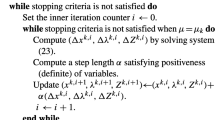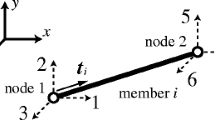Abstract
The paper addresses the classical problem of optimal truss design where cross-sectional areas and the positions of joints are simultaneously optimized. Se-veral approaches are discussed from a general point of view. In particular, we focus on the difference between simultaneous and alternating optimization of geometry and topology. We recall a rigorously mathematical approach based on the implicit programming technique which considers the classical single load minimum compliance problem subject to a volume constraint. This approach is refined leading to three new problem formulations which can be treated by methods of Mathematical Programming. In particular, these formulations cover the effect of melting end nodes, i.e., vanishing potential bars due to changes in the geometry. In one of these new problem formulations, the objective function is a polynomial of degree three and the constraints are bilinear or just sign constraints. Because heuristics is avoided, certain optimality properties can be proven for resulting structures. The paper closes with two numerical test examples.
Similar content being viewed by others
References
Achtziger W (1997) Topology optimization of discrete structures: an introduction in view of computational and nonsmooth aspects. In: Rozvany GIN (ed) Topology optimization in structural mechanics. Springer, Berlin Heidelberg New York, pp 57–100
Achtziger W (1998) Multiple load truss topology and sizing optimization: Some properties of minimax compliance. J Optim Theory Appl 98:255–280
Achtziger W (2006) Simultaneous optimization of truss topology and geometry, revisited. In: Bendsøe M, Olhoff N, Sigmund O (eds) IUTAM Symposium on topological design optimization of structures, machines and materials: status and perspectives. Springer, Berlin Heidelberg New York, pp 413–423
Achtziger W, Bendsøe MP, Ben-Tal A, Zowe J (1992) Equivalent displacement based formulations for maximum strength truss topology design. Impact Comput Sci Eng 4:315–345
Barbieri E, Lombardi M (1998) Minimum weight shape and size optimization of truss structures made of uncertain materials. Struct Multidisc Optim 16:147–154
Barta J (1957) On the minimum weight of certain redundant structures. Acta Tech Acad Sci Hung 18:67–76
Ben-Tal A, Kočvara M, Zowe J (1993) Two nonsmooth approaches to simultaneous geometry and topology design of trusses. In: Bendsøe M, Soares CM (eds) Topology optimization of structures. Kluwer Academic Publishers, Dordrecht, The Netherlands, pp 31–42
Bendsøe MP, Sigmund O (2003) Topology optimization: theory, methods and applications. Springer, Berlin Heidelberg New York
Bendsøe MP, Ben-Tal A, Zowe J (1994) Optimization methods for truss geometry and topology design. Struct Optim 7:141–159
Clarke FH (1983) Optimization and nonsmooth analysis. Wiley, New York, USA
Deb K, Gu S (2001) Design of truss-structures for minimum weight using genetic algorithms. Finite Elem Anal Des 37:447–465
Dobbs MW, Felton LP (1969) Optimization of truss geometry. ASCE J Struct Div 95:2105–2118
Dorn W, Gomory R, Greenberg H (1964) Automatic design of optimal structures. J Méc 3:25–52
Fleron P (1964) Minimum weight of trusses. Bygingsstatik Meddelelser 35:81–96
Galante M (1996) Genetic algorithms as an approach to optimize real-world trusses. Int J Numer Methods Eng 39:361–382
Gauvin J, Dubeau F (1982) Differential properties of the marginal function in mathematical programming. Math Program Stud 19:101–119
Gill P, Murray W, Saunders M (1997) User’s guide for SNOPT 5.3: A Fortran package for large-scale nonlinear programming. Tech. Rep. NA 97-5, Department of Mathematics, University of California, USA (revised 1998)
Hemp W (1973) Optimum structures. Clarendon Press, Oxford, UK
Hörnlein H (1979) Ein Algorithmus zur Strukturoptimierung von Fachwerkkonstruktionen (in German). Diplomarbeit, Department of Mathematics, Ludwigs-Maximilian-Universität, Munich, Germany
Imai K, Schmit L (1981) Configuration optimization of trusses. ASCE J Struct Div 107:745–756
Kirsch U (1990) On the relationship between optimum structural topologies and geometries. Struct Optim 2:39–45
Kočvara M, Zowe J (1995) How to optimize mechanical structures simultaneously with respect to geometry and topology. In: Olhoff N, Rozvany G (eds) First world congress of structural and multidisciplinary optimization. Pergamon, Oxford, UK, pp 135–140
Kočvara M, Zowe J (1996) How mathematics can help in design of mechanical structures. In: Griffiths D, Watson G (eds) Numerical analysis 1995. Longman Scientific and Technical, Harlow, UK, pp 76–93
Lev O (1978) Optimum truss geometry for two loading conditions. ASCE J Struct Div 104:1203–1210
Outrata J, Kocvara M, Zowe J (1998) Nonsmooth approach to optimization problems with equilibrium constraints: theory, applications and numerical results. Kluwer, Dordrecht, The Netherlands
Pedersen P (1970) On the minimum mass layout of trusses. In: AGARD Conference Proceedings No. 36 (AGARD-CP-36-70), NATO Research and Technology Organisation, pp 11.1–11.17, URL http://www.rta.nato.int/Abstracts.asp, Symposium on Structural Optimization, Istanbul, Turkey, 1969
Pedersen P (1972) On the optimal layout of multi-purpose trusses. Comput Struct 2:695–712
Pedersen P (1973) Optimal joint positions for space trusses. ASCE J Struct Div 99:2459–2476
Ringertz U (1985) On topology optimization for trusses. Eng Optim 9:21–36
Rozvany G, Bendsøe M, Kirsch U (1995) Layout optimization of structures. Appl Mech Rev 48:41–119
Svanberg K (1981) Optimization of geometry in truss design. Comput Methods Appl Mech Eng 28:63–80
Sved G (1954) The minimum weight of certain redundant structures. Aust J Appl Sci 5:1–9
Vanderplaats G, Moses F (1972) Automated design of trusses for optimum geometry. ASCE J Struct Div 98:671–690
Author information
Authors and Affiliations
Corresponding author
Additional information
This research was supported by the German-Czech DAAD–AV ČR project D–CZ 7/05–06.
Rights and permissions
About this article
Cite this article
Achtziger, W. On simultaneous optimization of truss geometry and topology. Struct Multidisc Optim 33, 285–304 (2007). https://doi.org/10.1007/s00158-006-0092-0
Received:
Revised:
Published:
Issue Date:
DOI: https://doi.org/10.1007/s00158-006-0092-0




